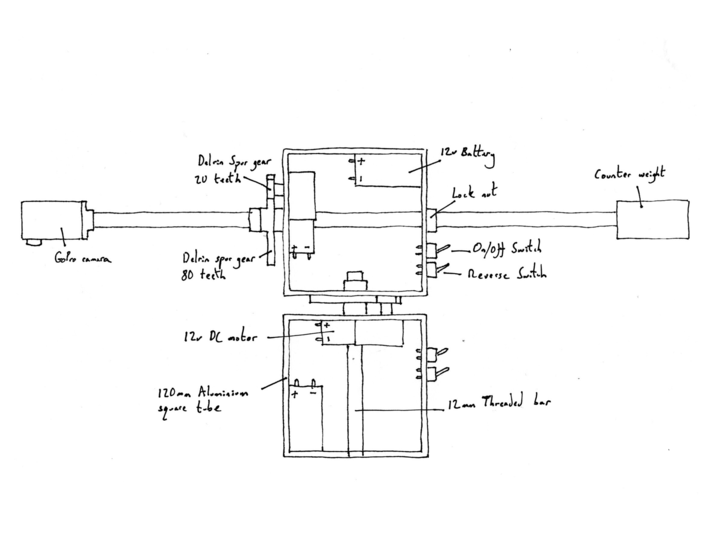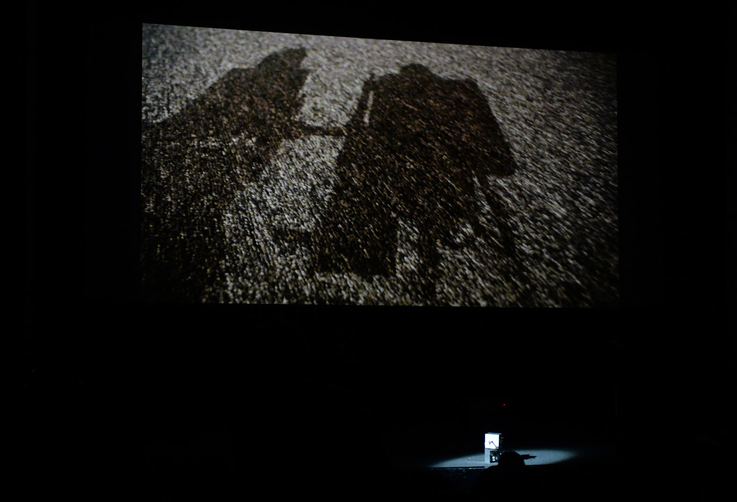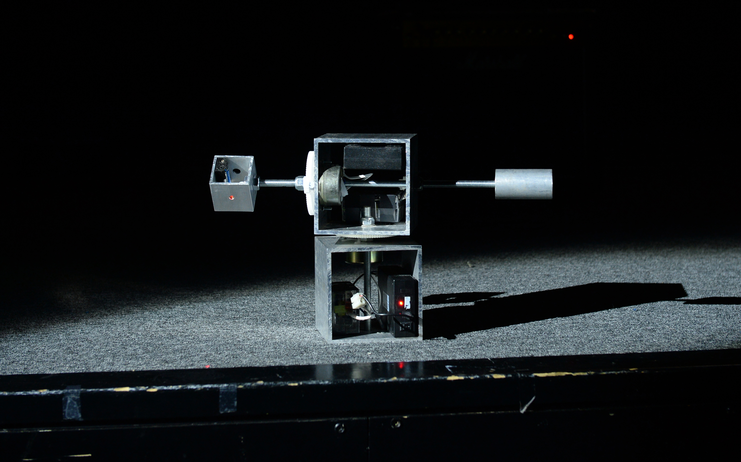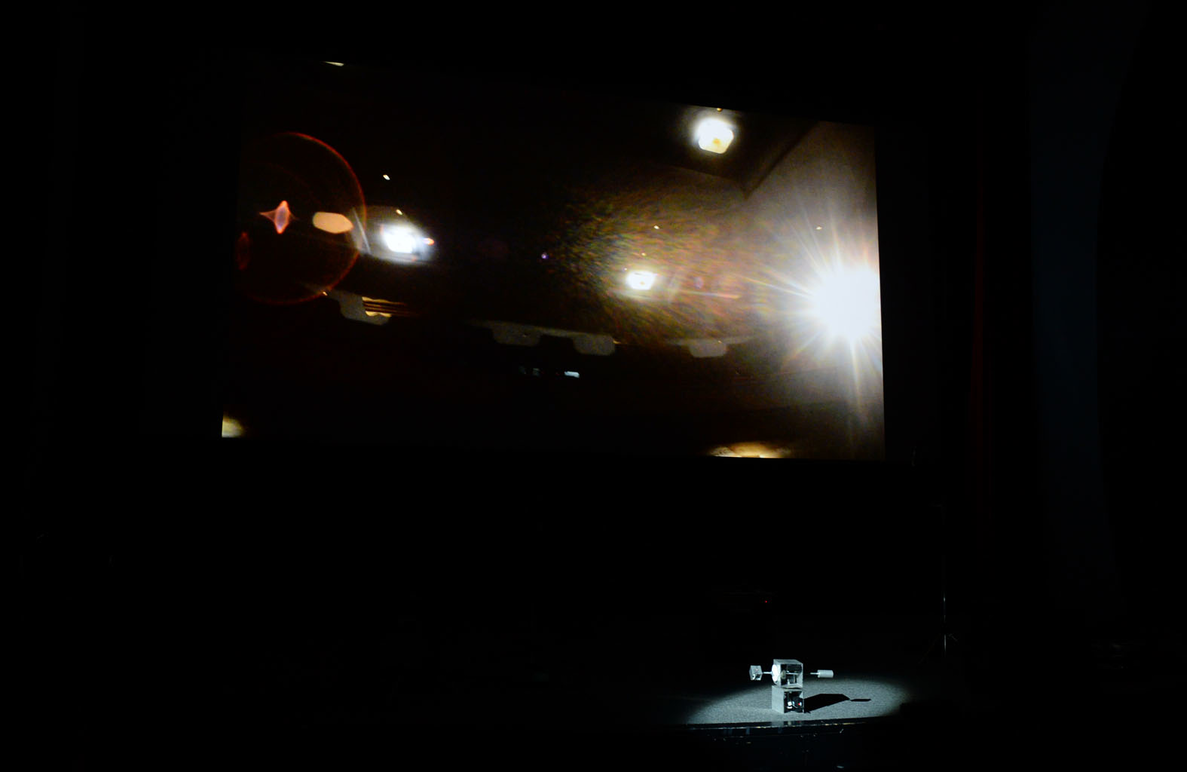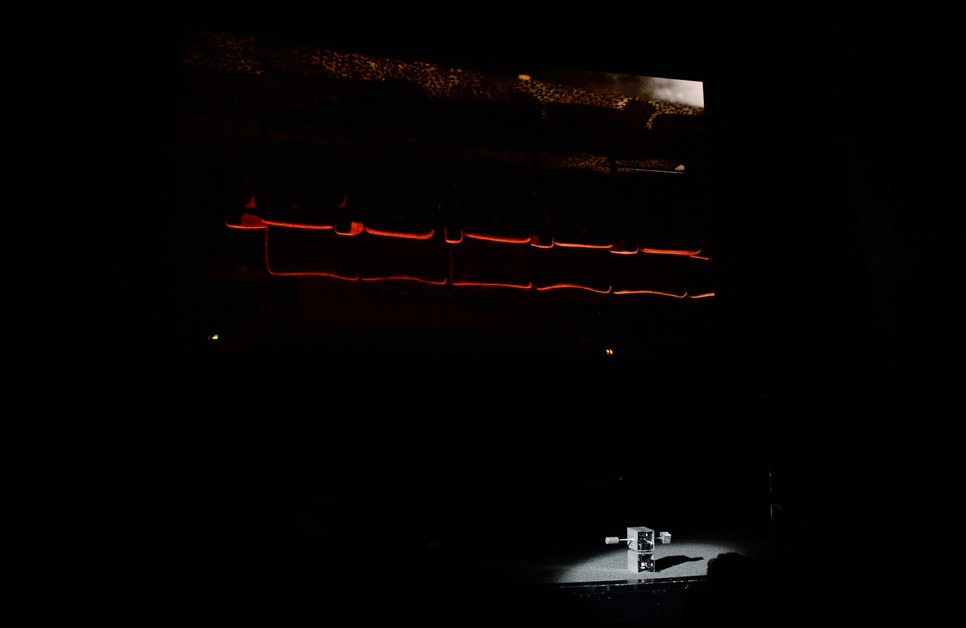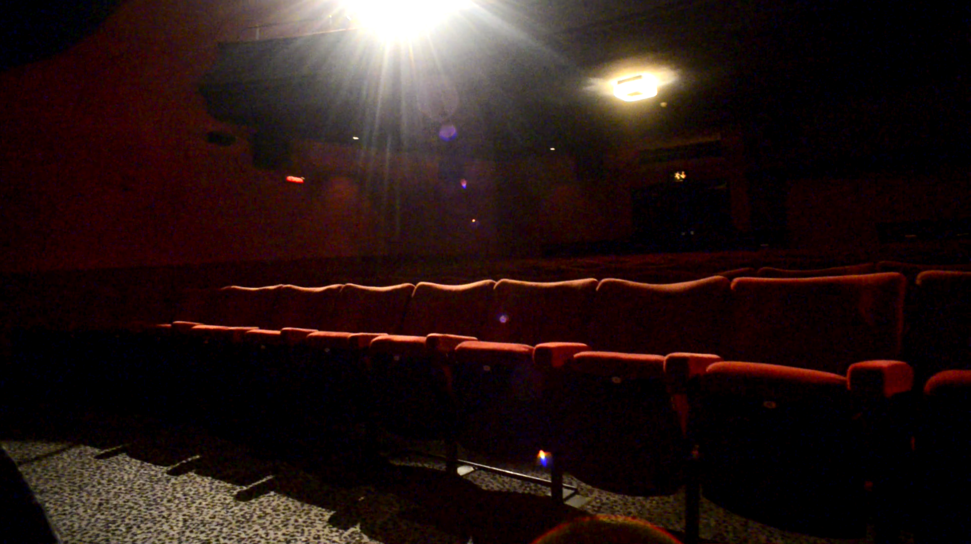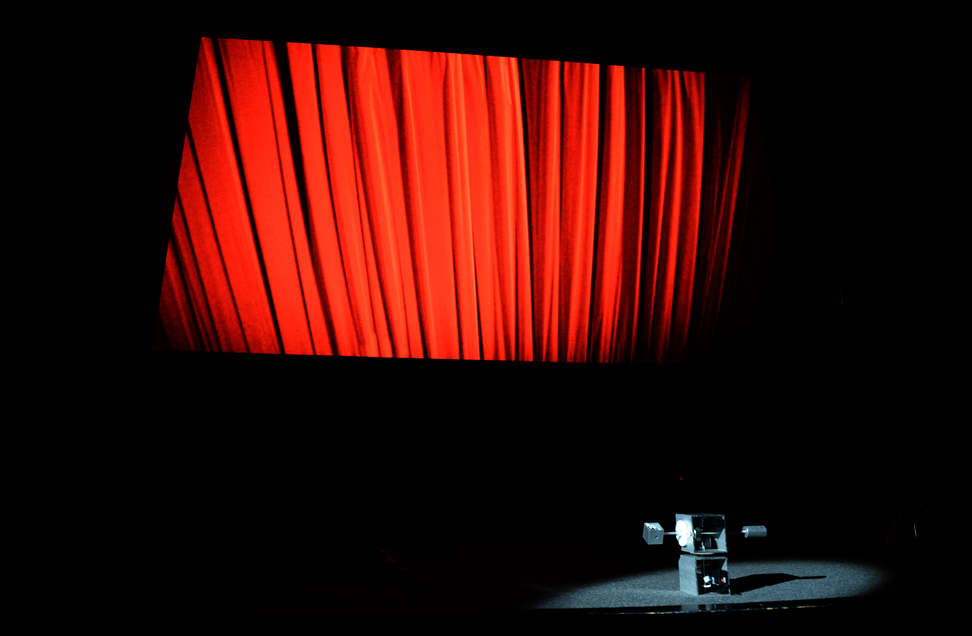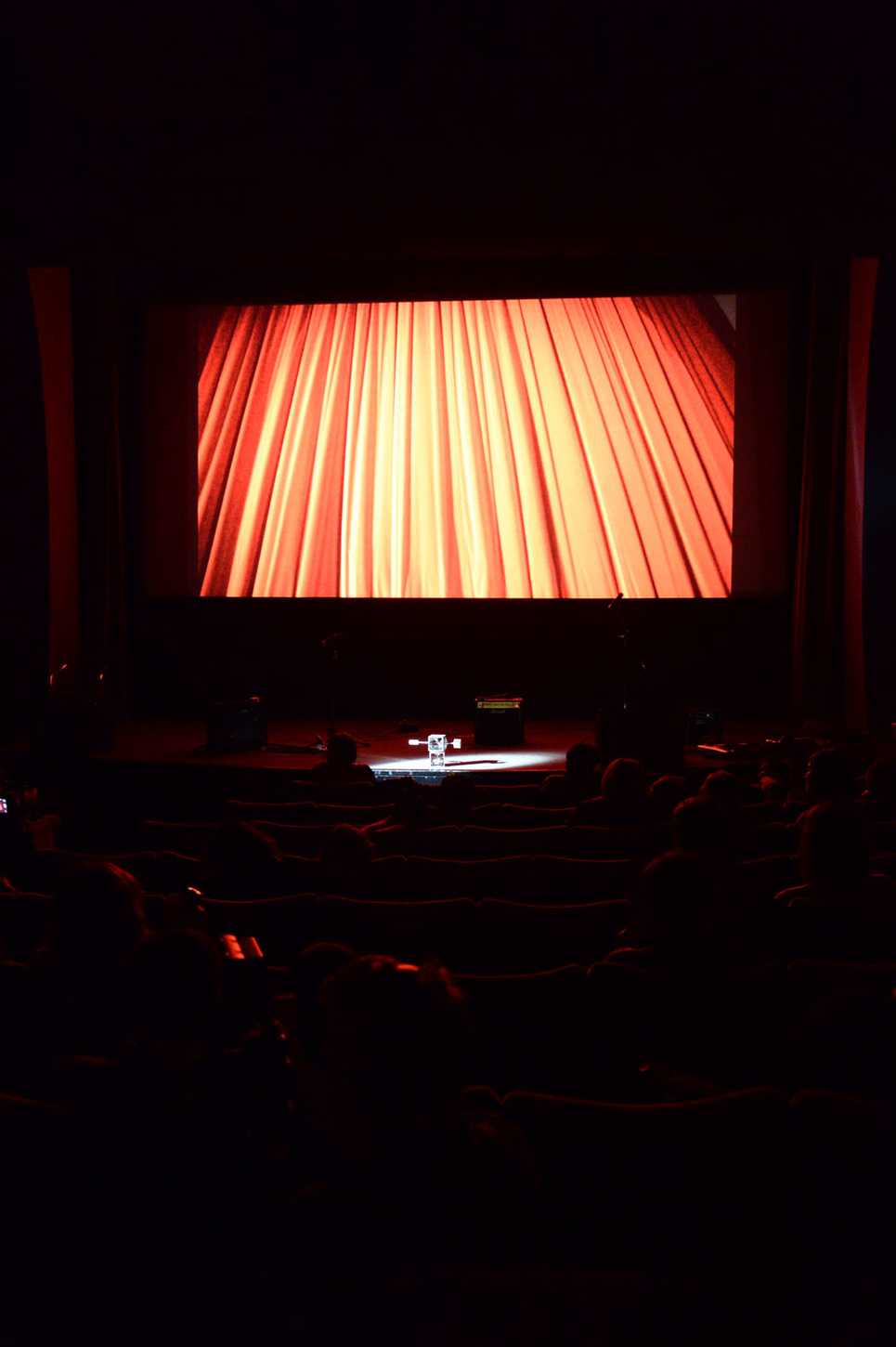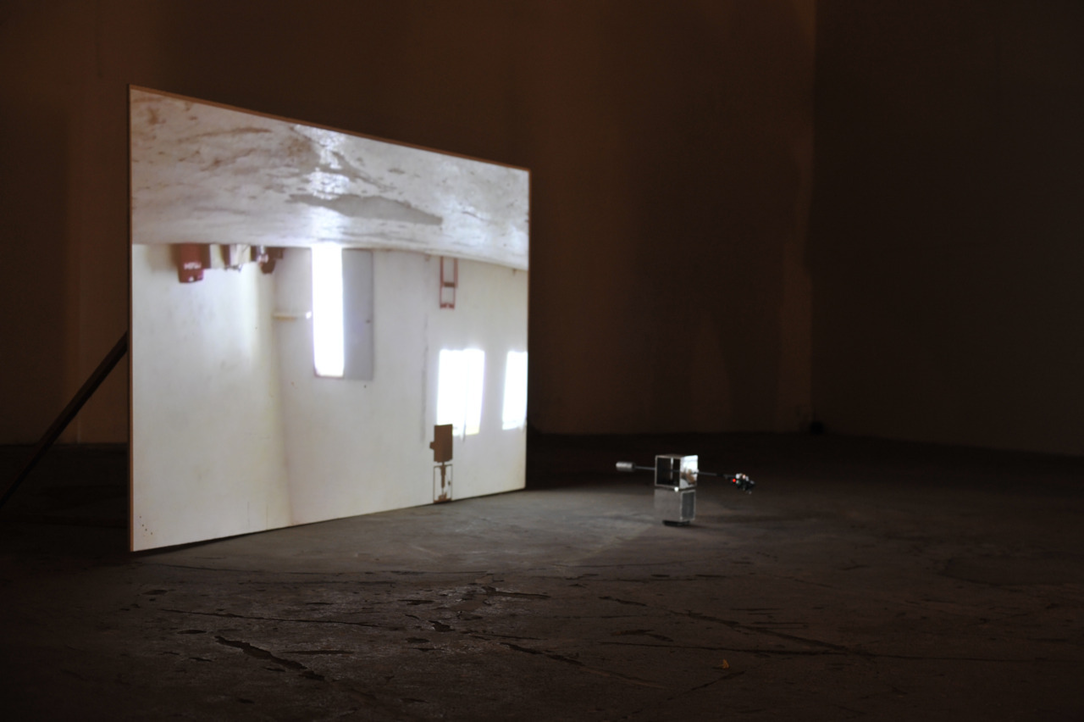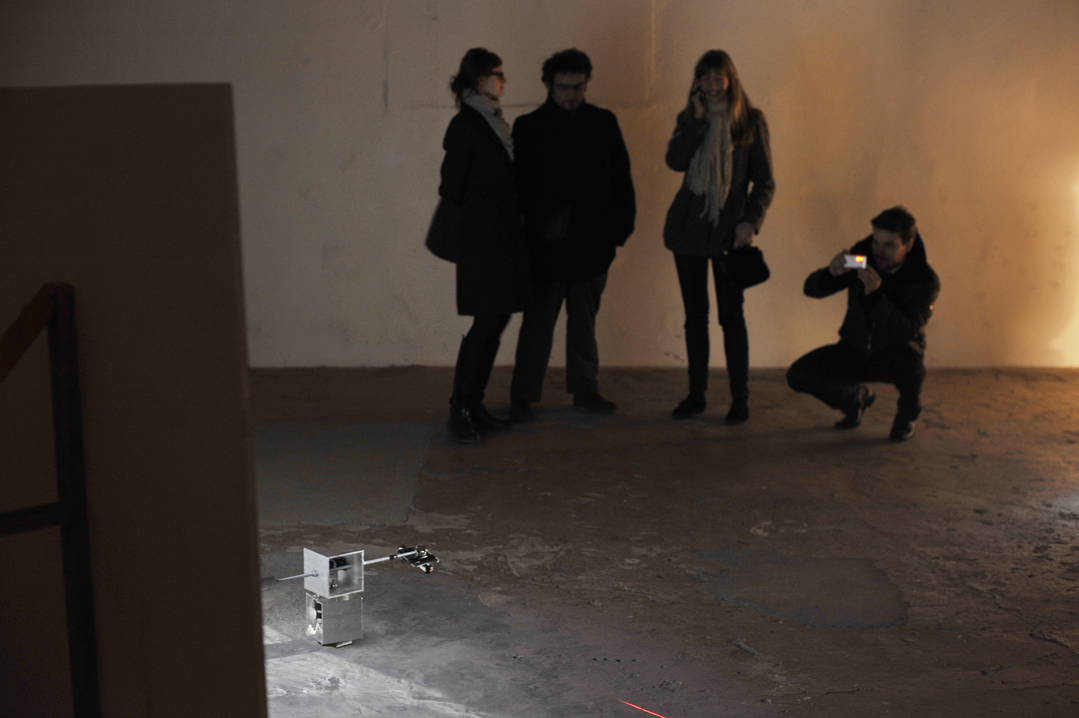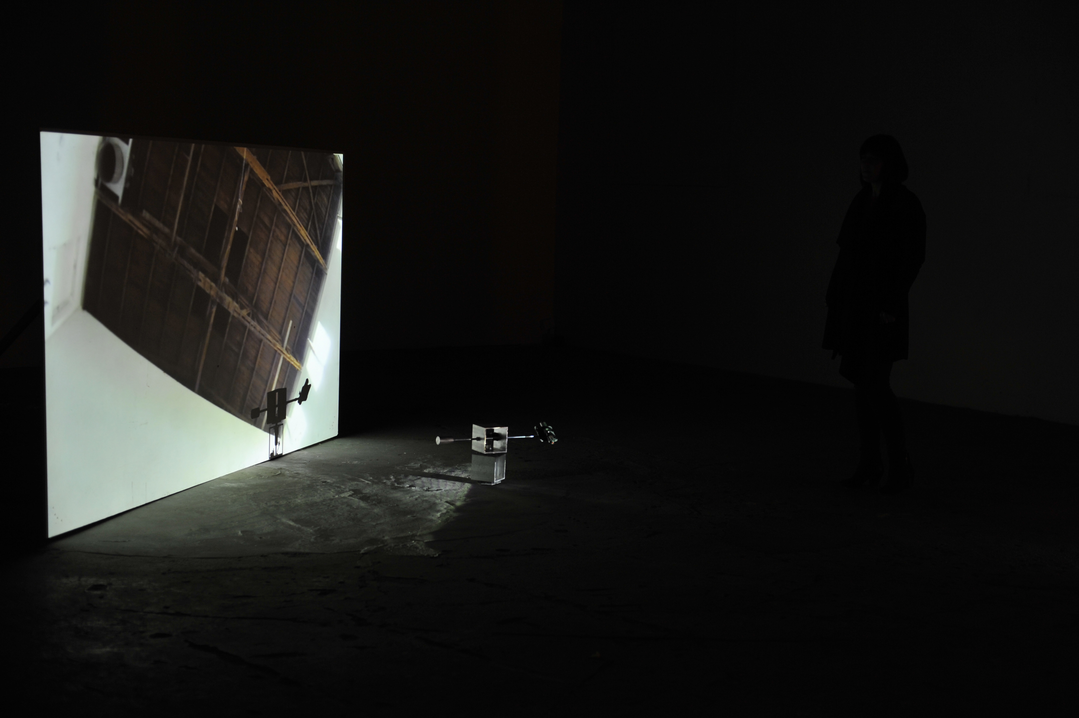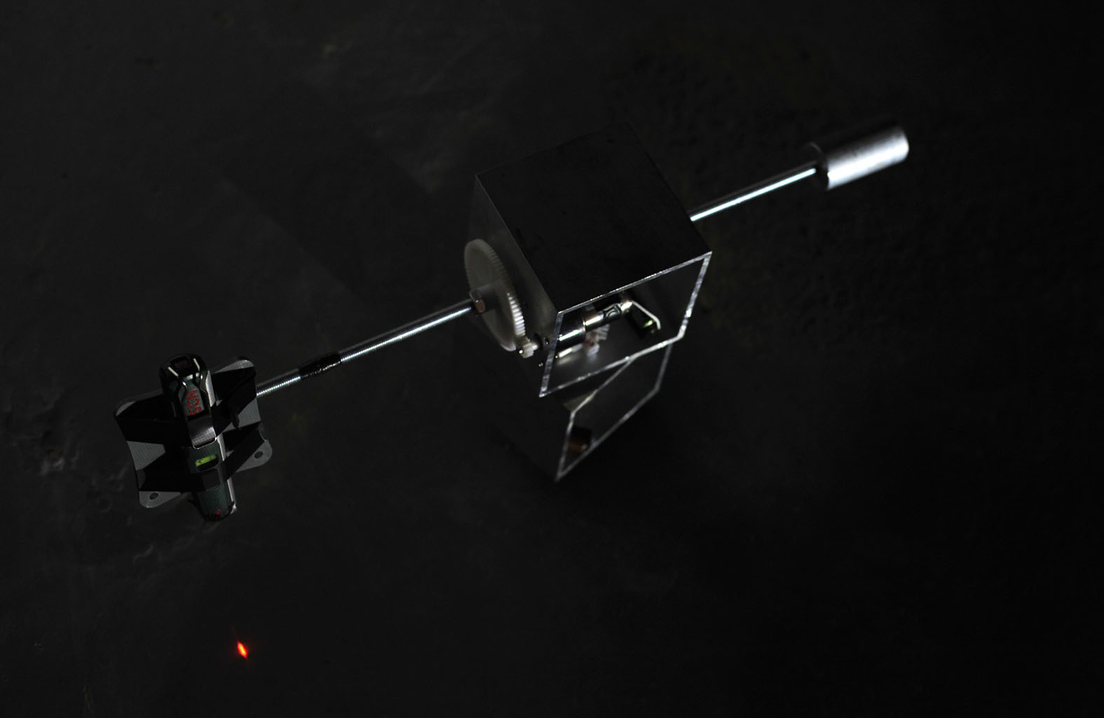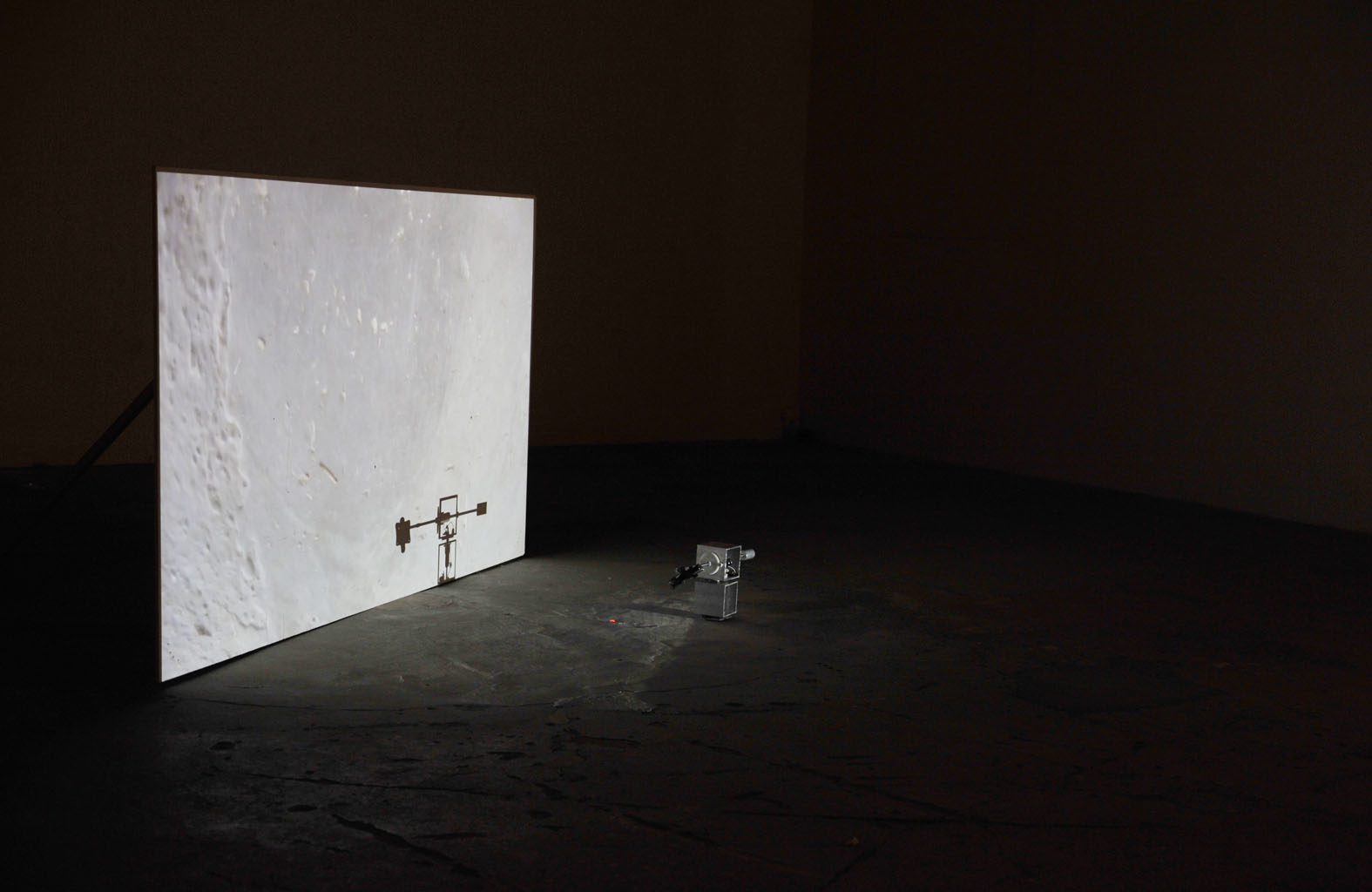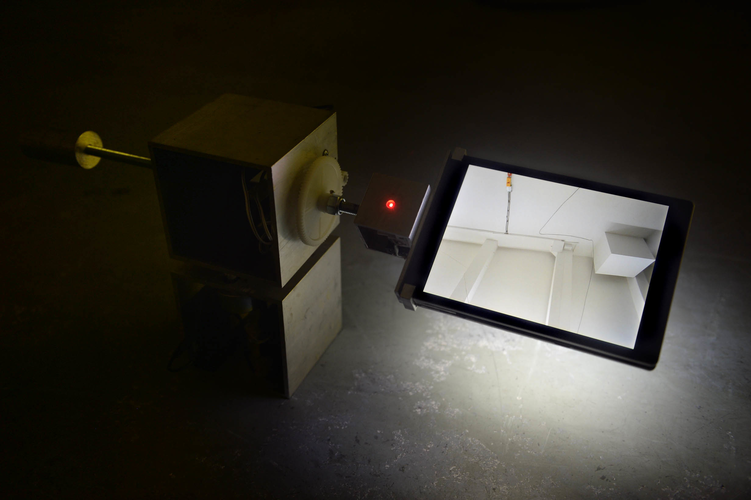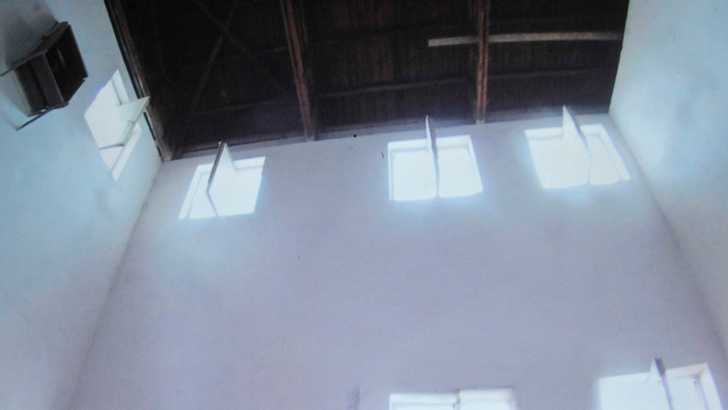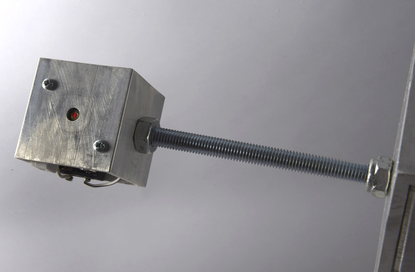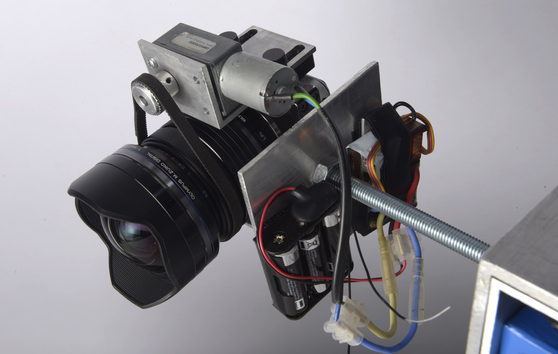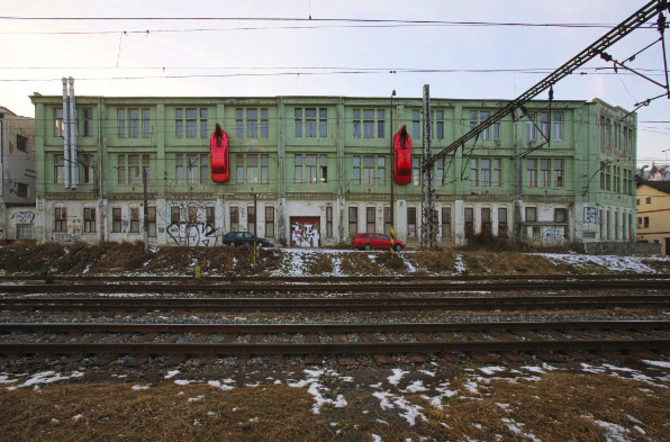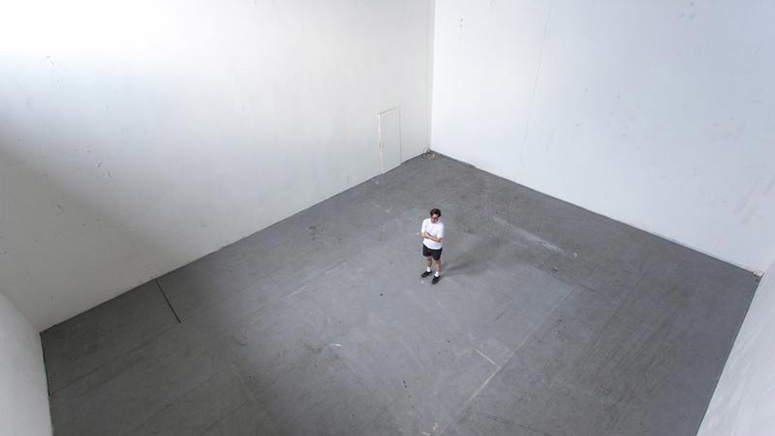Reference Rio
Reference Rio explores the Rio cinema in London, an independent art cinema constantly under threat of closure. The cinema is first filmed using the 360-degree rig, recording every detail of the empty architectural site, with the house lights on and the curtains closed. The pre-recorded film of the auditorium is then projected onto the cinema screen. The same rig is then used to track the movement of the recording device, by replacing the camera with a laser. As the audience ‘maps’ the projection to the laser within the ‘physical’ cinema space, a complex relationship occurs between artwork, audience and site.
The projected image has two roles: one to locate (anchor the audience within the cinema space) and the other to disorientate (see the cinema space in a new way). Thus, physical space, typically a motionless entity that one can passively inhabit, is transformed into ‘activated’ live space. The primary experience of watching and the secondary experience of representing are merged. The audience becomes aware of their position within the room and within the filmic space depicted in the projection, through a machine that records the space in the past and acts in the present. The device is a major part of the site-specific construct; rather than being merely an invisible tool, its performance is the main subject of the artwork.
Reference Rio responds to the actual cinema space, the 1930s auditorium, a traditional cinema experience, with plush red velvet seats and long red curtains that swish back before the film starts.
The 360-degree movement of the field of vision affects the audience's relationship with physical space and time. This work questions the act of perception and the definition of time, space, surface, and material, and it forces the spectator to return to her/his own capabilities for meaning-making.
The cinema audience, who traditionally favour represented time over the passage of actual time, becomes lost in narrative time. Michel de Certeau in The Practice of Everyday Life (1984) addresses exactly this: the primacy of a representational way of looking over the lived, rhythmic spaces of the city as he looks down from the World Trade Centre in New York. Reference Rio reverses this priority and focuses the attention on spectator time, which encourages one to notice one’s physical presence in the cinema site. This lived experience is often lost when we do not attend to the actual space of the cinema when watching a film.
Reference Rio creates a tension between space, time and the medium by discarding the anthropomorphic view of the architecture, and by constructing a new visual representation of the physical site in which the audience is seated. It forces the viewer to actively look, engage and experience the site, as opposed to the passive consumption of space, answering Parveen Adams’s wish: “what we need is respite from an entire system of seeing and space that is bound up with mastery and identity. To see differently, albeit for a moment, allows us to see anew” (Adams, 1998, p.56).
“I was at first trying to understand if it was a live feed and trying to negotiate my position within the film. Then, when I realized it wasn’t, I was caught in the experience of the video and feeling my body moving with the 'camera eye', leading me to wonder if I was experiencing the site from a human or machine point of view.” (Audience feedback)
“I not only felt like I became the machine by the power of filmic illusion (when looking at the projection, I felt as I was moving with the rig), but also because of my relation to the laser pointer attached to the rig, I was becoming incredibly aware of my existence and position within the room, and within the filmic space depicted in the projection.” (Audience feedback)
“I honestly thought the film was live, I was expecting to see myself on the cinema screen, I’m so used to live surveillance type work." (Audience feedback)
“It is interesting to feel how the presence of the machine changes the essence of space. Its sound and automated movement makes its presence striking to me, and I believe this adds immensely to the experience” (Audience feedback)
“When I noticed the laser pointer, leading my eyes to the point the camera had once filmed, I started to negotiate my relation not only to the film but also to the space. What first seemed to be about a machine and space became a triangle: machine-space-human. I was therefore constantly negotiating the limits between illusion of film and reality.” (Audience feedback)
“It would seem she constructs her machines, primes them, and steps away to allow them to complete her work as if they have an intelligence of their own.” (Audience feedback)
“I became part of space and film through a machine that recorded the space in the past and acted in the present (through its motion and sound, and through the laser pointer and the synchronized projection). The space was no longer a motionless entity that I could explore or passively inhabit, but it became 'activated'". (Audience feedback)
"I think the artist wanted to expose the space and wanted the audience to experience what happens if you magnify the sound of the room as it actually is. The space feels alive." (Audience feedback)
"The filming rig is used to make reference to the architectural site via a small laser pointer, attached where the camera has once been. This makes me equally aware of both the filmic space and the physical space in which I am standing". (Audience feedback)
There is a split between attention to the ‘inside’ of the frame (the projection screen) and the ‘outside’ of the frame (the gallery space around the screen). The film on screen makes reference to the space around it, thus connecting the projected space with the architectural site. It serves to connect the image to the gallery space suggesting the spilling over of the image into the viewer’s space.
A variety of different rigs are made that explore this notion of the image/tracking device. In this rig a monitor is installed where the camera was once mounted and then a laser is fixed to the opposite end, as the rig turns 360 degrees, the laser tracks in physical space the image on the screen. This has potential, but in a large site it is difficult to locate yourself in relation on the small screen.
A single laser is attached to where the camera once filmed, as the rig turns the laser travels through the space, projecting a beam of light around the space, from ceiling to floor. The laser invites the audience to follow it in the darkness.
Remote controlled focus for the camera — to enable the camera on the 360-degree rig to change focus, from 10cm when pointing at the ground, to infinity when pointing at the ceiling, a remote controlled focus device was attached using a small worm gear motor and a timing belt.
Kostka
Kostka performs one of the galleries at MeetFactory (centre for contemporary art) in Prague. The gallery is shaped as a cube (cube = Kostka in Czech), converted from what used to be the boiler room of a technical glass manufacturing works. The 360-degree motorised rig is placed in the centre of the space and records the visuals and sound of the empty gallery. The footage is projected on a large floating screen, presented in the centre of the space when the room is cleared and in darkness. The represented image comes into critical conjunction with the actual space of the gallery and the pre-recorded sounds on speakers around the space amplify the acoustics in the room, without using pre-recorded material from elsewhere. Kostka exposes the space sound itself and allows the audience to experience what happens when your attention is drawn to the actual sound of the room. Sound promotes the coherence of the visual representation of site and tells us what we feel about what we see. Field recording is more than simply recording sound in situ, it decontextualizes sound, lifting it out of place and sending it into wider circulation.
To aid the connection of site and film, the original filming rig is used to make reference to the architectural site via a moving projector, attached where the camera had once been. This makes the viewer equally aware of both the filmic space and the physical space in which they are standing. The pre-recorded image and sound of the gallery is physically mapped in synchronised time with the site, the viewer’s position within the space is entirely mediated by the machine.




